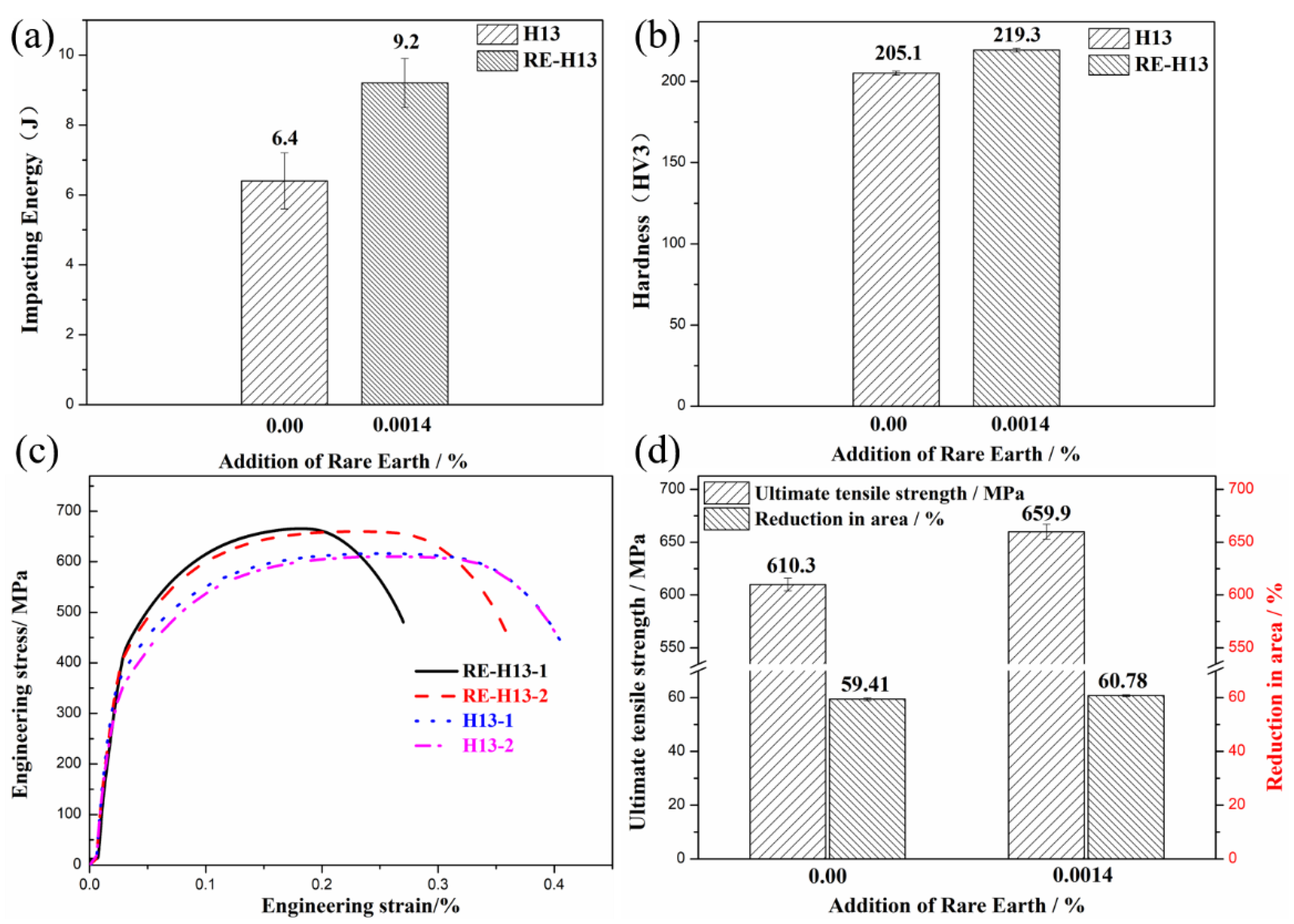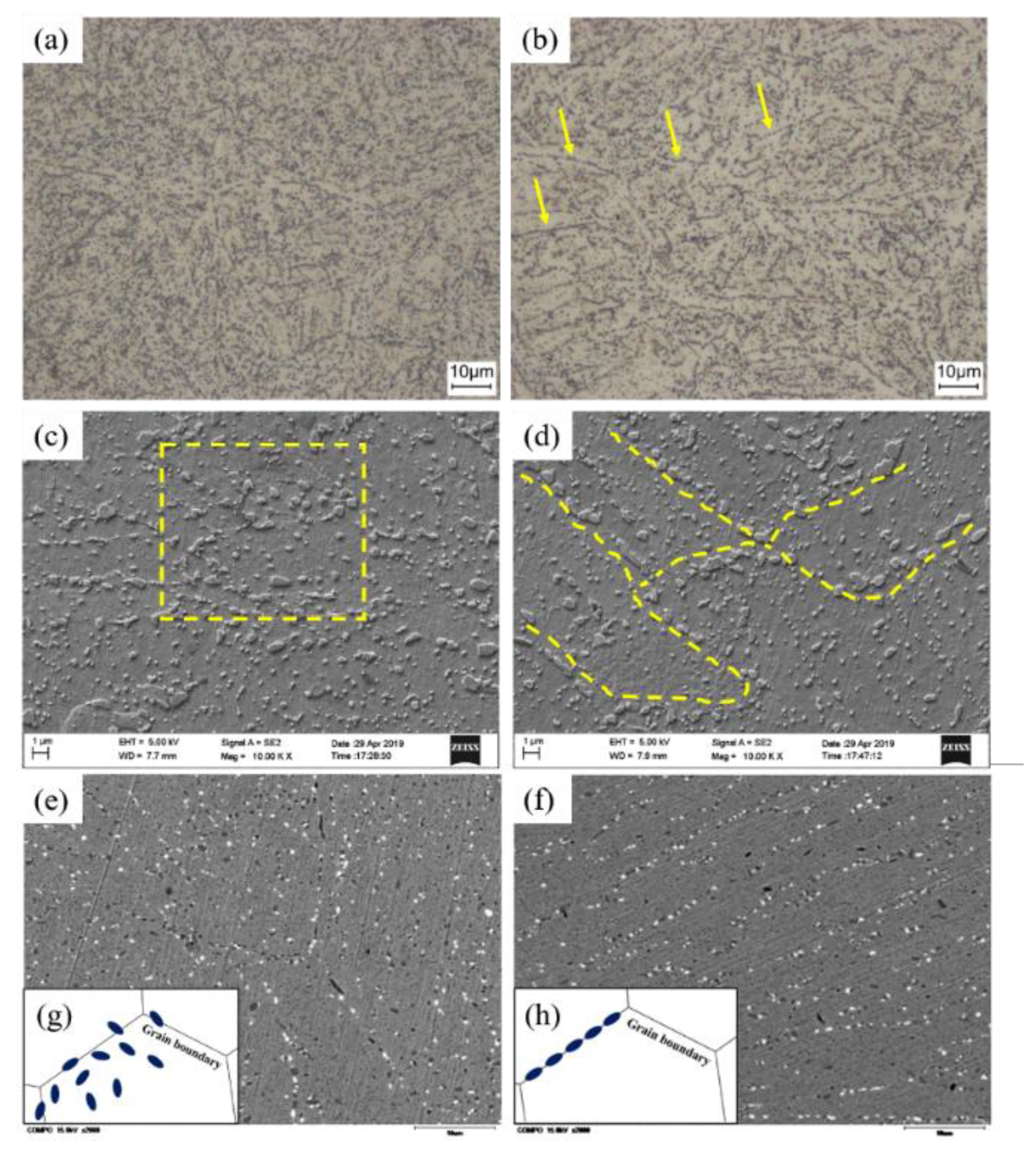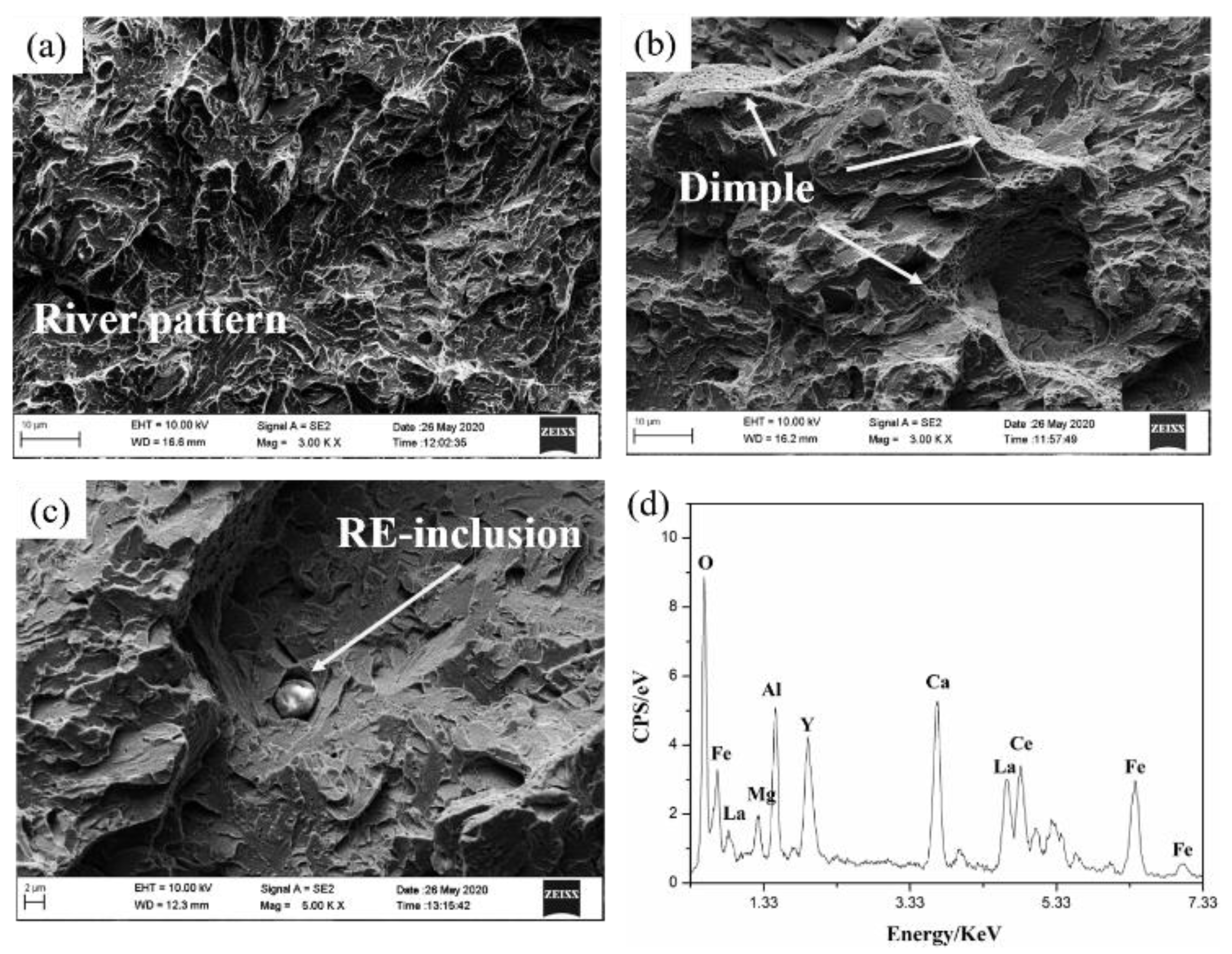Effects of Rare Earth Elements on Microstructure and Mechanical Properties of H13 Die Steel
Abstract
:1. Introduction
2. Materials and Methods
3. Results and Discussion
3.1. Effect of Rare Earth on Mechanical Properties
3.2. Effect of Rare Earth on Microstructure
3.3. Effect of Rare Earth on Phase Transformation Point
3.4. Effect of Rare Earth on Impact Fracture Morphology
4. Conclusions
- With the addition of RE, the longitudinal impact energy and hardness increased by 43.7% and 6.9%, respectively, the UTS increased by ~50 MPa, the elongation rate decreased by 8%, and the reduction in area was almost constant.
- The fraction of M23C6 carbides along the grain boundaries in the RE-H13 die steel was increased and hindered the migration of grain boundaries in the tensile process. The resistance to crack formation and propagation were improved in the RE-H13 die steel. In addition, due to the addition of RE, the Ac3 temperature increased by 11.4 °C, indicative of the RE-induced nailing effect on the carbon atoms.
- RE can yield significant modification in the inclusions and improve inclusion resistance to crack formation and expansion. Therefore, RE promotes the transition of brittle–type failure to ductile–type failure and the reduction in area remains relatively constant.
Author Contributions
Funding
Acknowledgments
Conflicts of Interest
References
- Gao, J.; Fu, P.; Liu, H.; Li, D. Effects of Rare Earth on the Microstructure and Impact Toughness of H13 Steel. Metals 2015, 5, 383–394. [Google Scholar] [CrossRef] [Green Version]
- Rafi, H.K.; Ram, G.; Phanikumar, G.; Rao, K.P. Microstructural evolution during friction surfacing of tool steel H13. Mater. Des. 2011, 32, 82–87. [Google Scholar] [CrossRef]
- Taktak, S. Some mechanical properties of borided AISI H13 and 304 steels. Mater. Des. 2007, 28, 1836–1843. [Google Scholar] [CrossRef]
- Recco, A.A.C.; Tschiptschin, A.P. Structural and mechanical characterization of duplex multilayer coatings deposited onto H13 tool steel. J. Mater. Res. Technol. 2012, 1, 182–188. [Google Scholar] [CrossRef] [Green Version]
- Das, K.; Alphonsa, J.; Ghosh, M.; Ghanshyam, J.; Rane, R.; Mukherjee, S. Influence of pretreatment on surface behavior of duplex plasma treated AISI H13 tool steel. Surf. Interfaces 2017, 8, 206–213. [Google Scholar] [CrossRef]
- Hanghang, L.; Paixian, F.; Hongwei, L.; Chen, S.; Jinzhu, G.; Dianzhong, L. Carbides Evolution and Tensile Property of 4Cr5MoSiV1 Die Steel with Rare Earth Addition. Metals 2017, 7, 436. [Google Scholar]
- Li, Y.; Liu, C.; Zhang, T.; Jiang, M.; Peng, C. Inclusions modification in heat resistant steel containing rare earth elements. Ironmaking Steelmaking 2016, 45, 76–82. [Google Scholar] [CrossRef]
- Yang, C.; Luan, Y.; Li, D.; Li, Y. Effects of rare earth elements on inclusions and impact toughness of high-carbon chromium bearing steel. J. Mater. Sci. Technol. 2019, 35, 1298–1308. [Google Scholar] [CrossRef]
- Yan, H.; Hu, Y.; Zhao, D. Influence of Rare Earth on Dynamic Recrystallization Behavior of As–Cast 30Mn Steel. Adv. Mater. Sci. Eng. 2018, 2018, 1–9. [Google Scholar] [CrossRef] [Green Version]
- Zhang, X.; Wei, W.; Cheng, L.; Liu, J.; Wu, K.; Liu, M. Effects of niobium and rare earth elements on microstructure and initial marine corrosion behavior of low-alloy steels. Appl. Surf. Sci. 2019, 475, 83–93. [Google Scholar] [CrossRef]
- Chen, L.; Ma, X.; Wang, L.; Ye, X. Effect of rare earth element yttrium addition on microstructures and properties of a 21Cr–11Ni austenitic heat–resistant stainless steel. Mater. Des. 2011, 32, 2206–2212. [Google Scholar] [CrossRef]
- Pan, F.; Zhang, J.; Chen, H.L.; Su, Y.H.; Kuo, C.L.; Chen, S.H.; Lin, K.J.; Hsieh, P.H.; Hwang, W.S. Effects of Rare Earth Metals on Steel Microstructures. Materials 2016, 9, 417. [Google Scholar] [CrossRef] [PubMed] [Green Version]
- Jiang, Z.; Wang, P.; Li, D.; Li, Y. Effects of rare earth on microstructure and impact toughness of low alloy Cr–Mo–V steels for hydrogenation reactor vessels. J. Mater. Sci. Technol. 2020, 45, 1–14. [Google Scholar] [CrossRef]
- Zhou, X.; Yin, X.; Fang, F.; Jiang, J.; Zhu, W. Influence of rare earths on eutectic carbides in AISI M2 high speed steel. J. Rare Earths 2012, 30, 1075–1078. [Google Scholar] [CrossRef]
- Fu, H.; Xiao, Q.; Li, Y. A study of the microstructures and properties of Fe–V–W–Mo alloy modified by rare earth. Mater. Sci. Eng. A 2005, 395, 281–287. [Google Scholar] [CrossRef]
- Wang, S.Q.; Jiang, Q.C.; Cui, X.H.; He, Z.M. Influence of trace elements and heat treatment on carbide morphology and properties of CD-2 steel. Mater. Sci. Eng. A 1999, 264, 172–176. [Google Scholar] [CrossRef]
- Hamidzadeh, M.A.; Meratian, M.; Saatchi, A. Effect of cerium and lanthanum on the microstructure and mechanical properties of AISI D2 tool steel. Mater. Sci. Eng. A 2013, 571, 193–198. [Google Scholar] [CrossRef]
- Boccalini, M.; Correa, A.V.O.; Goldenstein, H. Rare earth metal induced modification of γ–M2C, γ–M6C, and γ–MC eutectics in as cast M2 high speed steel. J. Mater. Sci. Technol. 1999, 15, 621. [Google Scholar] [CrossRef]
- Hufenbach, J.; Helth, A.; Lee, M.H.; Wendrock, H.; Giebeler, L.; Choe, C.Y.; Kim, K.H.; Kühn, U.; Kim, T.S.; Eckert, J. Effect of cerium addition on microstructure and mechanical properties of high–strength Fe85Cr4Mo8V2C1 cast steel. Mater. Sci. Eng. A 2016, 674, 366–374. [Google Scholar] [CrossRef]
- Kang, M.; Park, G.; Jung, J. –G.; Kim, B.–H.; Lee, Y.–K. The effects of annealing temperature and cooling rate on carbide precipitation behavior in H13 hot–work tool steel. J. Alloys Compd. 2015, 627, 359–366. [Google Scholar] [CrossRef]
- Hao, F.; Li, D.; Dan, T.; Ren, X.; Liao, B.; Yang, Q. Effect of rare earth oxides on the morphology of carbides in hardfacing metal of high chromium cast iron. J. Rare Earths 2011, 29, 168–172. [Google Scholar] [CrossRef]
- Zhu, J.; Zhang, Z.; Xie, J. Improving strength and ductility of H13 die steel by pre–tempering treatment and its mechanism. Mater. Sci. Eng. A 2019, 752, 101–114. [Google Scholar] [CrossRef]
- Sanaty–Zadeh, A.; Luo, A.A.; Stone, D.S. Comprehensive study of phase transformation in age–hardening of Mg–3Nd–0.2Zn by means of scanning transmission electron microscopy. Acta Mater. 2015, 94, 294–306. [Google Scholar] [CrossRef] [Green Version]
- Seol, J.B.; Haley, D.; Hoelzer, D.T.; Kim, J.H. Influences of interstitial and extrusion temperature on grain 310 boundary segregation, Y−Ti−O nanofeatures, and mechanical properties of ferritic steels. Acta Mater. 2018, 153, 71–85. [Google Scholar] [CrossRef]
- Gao, X.; Ren, H.; Wang, H.; Chen, S. Effect of lanthanum on the precipitation and dissolution of NbC in microalloyed steels. Mater. Sci. Eng. A 2017, 683, 116–122. [Google Scholar] [CrossRef]
- Chen, R.; Wang, Z.; Zhu, F.; Zhao, H.; Qin, J.; Zhong, L. Effects of rare–earth micro–alloying on microstructures, carbides, and internal friction of 51CrV4 steels. J. Alloys Compd. 2020, 824, 153849. [Google Scholar] [CrossRef]
- Zhu, J.; Xie, J.; Zhang, Z.; Huang, H. Microstructure and Obdurability Improvement Mechanisms of the La–Microalloyed H13 Steel. Steel Res. Int. 2018, 89, 1800044. [Google Scholar] [CrossRef]
- Ahn, J. –H.; Jung, H.–D.; Im, J.–H.; Jung, K.H.; Moon, B.–M. Influence of the addition of gadolinium on the microstructure and mechanical properties of duplex stainless steel. Mater. Sci. Eng. A 2016, 658, 255–262. [Google Scholar] [CrossRef]
- Jingpei, X.; Aiqin, W.; Wenyan, W.; Jiwen, L.; Luoli, L. Effects of Rare Earths on Toughness of 31Mn2SiRE Wear–Resistance Cast Steel. J. Rare Earths 2006, 24, 401–404. [Google Scholar] [CrossRef]







| Element (wt.%) | C | Si | Mn | Cr | Mo | V | P | S | O | N | RE |
|---|---|---|---|---|---|---|---|---|---|---|---|
| H13 | 0.38 | 0.99 | 0.37 | 5.1 | 1.36 | 1.07 | 0.011 | 0.003 | 0.0009 | 0.0046 | - |
| RE-H13 | 0.39 | 1.04 | 0.38 | 5.1 | 1.34 | 1.04 | 0.012 | 0.003 | 0.0007 | 0.0045 | 0.0014 |
© 2020 by the authors. Licensee MDPI, Basel, Switzerland. This article is an open access article distributed under the terms and conditions of the Creative Commons Attribution (CC BY) license (http://creativecommons.org/licenses/by/4.0/).
Share and Cite
Chen, R.; Wang, Z.; He, J.; Zhu, F.; Li, C. Effects of Rare Earth Elements on Microstructure and Mechanical Properties of H13 Die Steel. Metals 2020, 10, 918. https://doi.org/10.3390/met10070918
Chen R, Wang Z, He J, Zhu F, Li C. Effects of Rare Earth Elements on Microstructure and Mechanical Properties of H13 Die Steel. Metals. 2020; 10(7):918. https://doi.org/10.3390/met10070918
Chicago/Turabian StyleChen, Rongchun, Zhigang Wang, Jianguo He, Fusheng Zhu, and Chunhong Li. 2020. "Effects of Rare Earth Elements on Microstructure and Mechanical Properties of H13 Die Steel" Metals 10, no. 7: 918. https://doi.org/10.3390/met10070918




